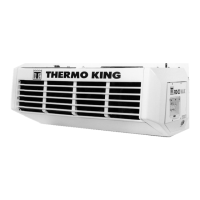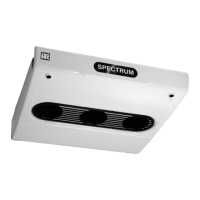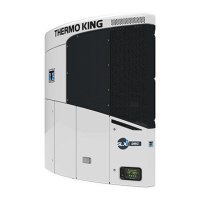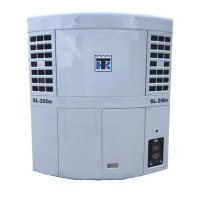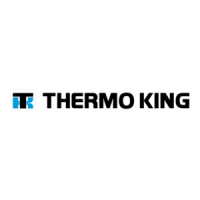
Do you have a question about the Thermo King RD-II SR 50 230/3/60 EEC and is the answer not in the manual?
| Brand | Thermo King |
|---|---|
| Model | RD-II SR 50 230/3/60 EEC |
| Category | Refrigerator |
| Language | English |
General safety guidelines for operation and maintenance.
Warnings and precautions regarding automatic unit startup and shutdown procedures.
Safety protocols for handling refrigerants and first aid for exposure.
Precautions for handling refrigeration oil and first aid for contact.
Safety measures for high voltage components and procedures during work.
Precautions for working with low voltage control circuits.
Specific safety guidelines for working with the µP-T microprocessor system.
Details on engine type, capacity, oil, RPM, and pressure specifications.
Guidelines for setting and checking belt tension across various components.
Technical specifications for R-134a and R-404A refrigeration systems.
Specifications for the engine clutch and electrical control system components.
Recommended inspection and service intervals for the engine components.
Scheduled checks for electrical system components and functions.
Inspection tasks for the refrigeration system components and functions.
Routine checks for structural integrity and physical condition of the unit.
Introduction to the RD-II SR unit, its models, and power sources.
Details on the µP-T microprocessor and its functions.
Information about the specific compressor used in the RD-II SR unit.
Description of the unit's instruments, display, and remote indicators.
Overview of fuses, cutouts, and relief valves protecting the unit.
Procedures for operating the unit, including pre-trip and post-trip checks.
Overview of the µP-T microprocessor control system and its components.
Details on the main components of the µP-T control system.
Explanation of the microprocessor power switch and its function.
Information on the optional electric standby capability for Model 50 units.
Standard features on Model 50 units with electric standby.
Optional features available for Model 50 units with electric standby.
Description of the remote control panel, its keypad, and display functions.
Explanation of the display screen, its icons, and how to interpret them.
How to read the standard display and adjust the unit's setpoint.
Procedure for selecting CYCLE-SENTRY or Continuous mode.
Steps for starting the engine and initiating a manual defrost cycle.
How to check software revision and view system prompts and screens.
Procedures for viewing and clearing alarm codes detected by the system.
Understanding unit alarms and performing the self-check test.
General precautions and specific notes on alternators with integral regulators.
Procedures to diagnose the charging system before replacing components.
Troubleshooting excessive voltage and inspecting the battery.
Inspection of unit wiring, harnesses, and electrical contacts for issues.
Details on the 12 VDC charging system and the preheat buzzer function.
Information and testing procedures for the RPM sensor.
How glow plugs work and how to test them for proper function.
Checking fan rotation and adjusting the defrost air switch.
Air switch calibration and overview of the TherMax™ heating system.
Details on the engine's lubrication system, oil pressure, and sensors.
Procedures for changing engine oil and oil filters at recommended intervals.
Function and maintenance of the crankcase breather system.
Description of oil bath and dry type air cleaners and their maintenance.
Overview of the engine's closed circulating cooling system.
Procedures for checking, changing, and maintaining engine antifreeze.
Steps for bleeding the cooling system and selecting the correct thermostat.
Components and function of the engine's fuel system.
Procedures for bleeding air from the fuel system and addressing water contamination.
Maintenance and troubleshooting for the fuel filter and electric fuel pump.
Procedures for adjusting engine speed and timing the injection pump.
Checking individual cylinder timing and adjusting engine valve clearance.
Details about the fuel limit screw and emission regulations.
Installation and maintenance of engine mounts and the idler assembly.
Procedures for adjusting belt tension on various drive systems.
Information on the fuel solenoid, engine operation, and speed adjustments.
Steps for evacuating the refrigeration system and testing equipment.
Procedures for evacuating and charging the refrigeration system.
Methods for detecting leaks and testing refrigerant charge levels.
How to check the compressor oil level under different ambient temperatures.
Testing the high pressure cutout and performing compressor pump down.
Operation and repair of the three-way valve's bypass check valve.
Procedures for removing and installing the accumulator.
Steps for removing and installing the compressor.
Procedures for servicing the condenser/radiator coil.
Steps for replacing the liquid line check valve.
Procedures for removing and installing the dehydrator (filter-drier).
Procedures for removing and installing the evaporator coil.
Procedures for removing and installing the expansion valve assembly.
Procedures for removing and installing the heat exchanger.
Procedures for removing and installing the high pressure cutout switch.
Procedures for removing and installing the high pressure relief valve.
Procedures for removing and installing the pilot solenoid.
Procedures for removing and installing the pressure regulator valve.
Procedures for removing and installing the receiver tank.
Procedures for repairing the three-way valve assembly.
Information on refrigerants R-134a and R-404A, including identification and availability.
Recommended equipment and procedures for system cleanup with new refrigerants.
Information on the Thermo King Collector refrigerant recovery system.
Procedures for removing, repairing, and installing the throttling valve.
General inspection, cleaning, and lubrication of the clutch assembly.
Steps for disassembling the clutch and removing its housing.
Procedures for removing bearings and reassembling the clutch.
How to install bearing races and assemble the clutch hub.
Procedures for checking and tightening unit and engine mounting bolts.
Visual inspection points for the unit during pre-trip and scheduled maintenance.
Methods for cleaning evaporator and condenser coils.
Proper fan placement and checks for the defrost damper.
Steps to adjust the defrost damper for proper sealing.
Procedures for servicing the jackshaft assembly, including disassembly and reassembly.
Detailed procedures for overhauling the fanshaft assembly.
Steps for installing new bearings, splash guards, and oil seals.
Adjusting end play and installing components for the shaft assembly.
Instructions for installing the RD-II SR idler pulley seal.
Troubleshooting common engine starting problems and causes.
Diagnosing issues like engine stopping after start or lack of full power.
Identifying causes of excessive smoke and incorrect fuel-to-air ratio.
Diagnosing causes of engine knocking and overheating.
Troubleshooting low oil pressure and high oil consumption.
Diagnosing smoke causes and battery recharging issues.
Troubleshooting electric motor startup and operation problems.
Diagnosing issues related to contact chatter, welding, or rapid cycling.
Troubleshooting electric heater operation and battery recharging problems.
Table correlating symptoms to possible causes in refrigeration cycles.



